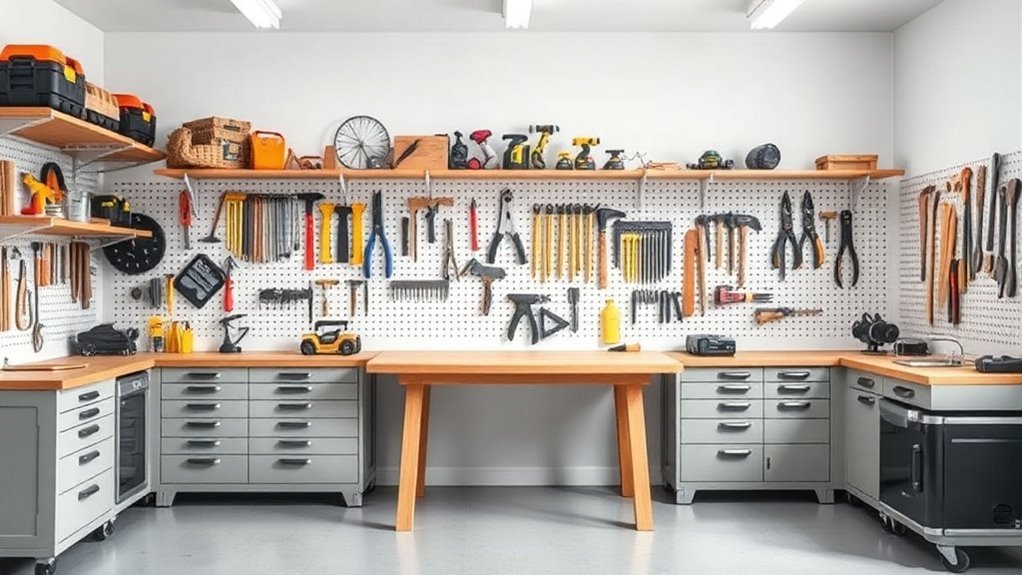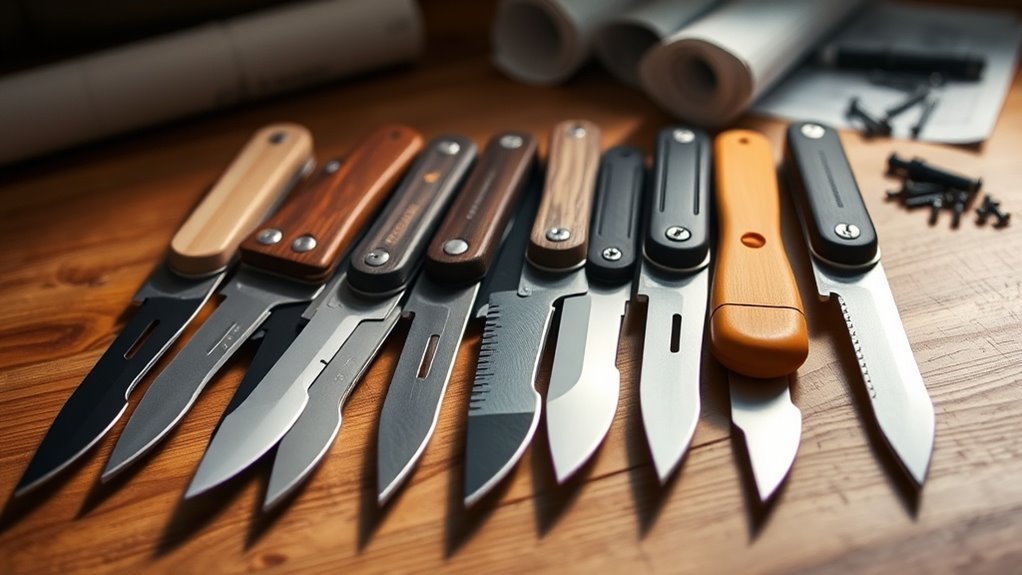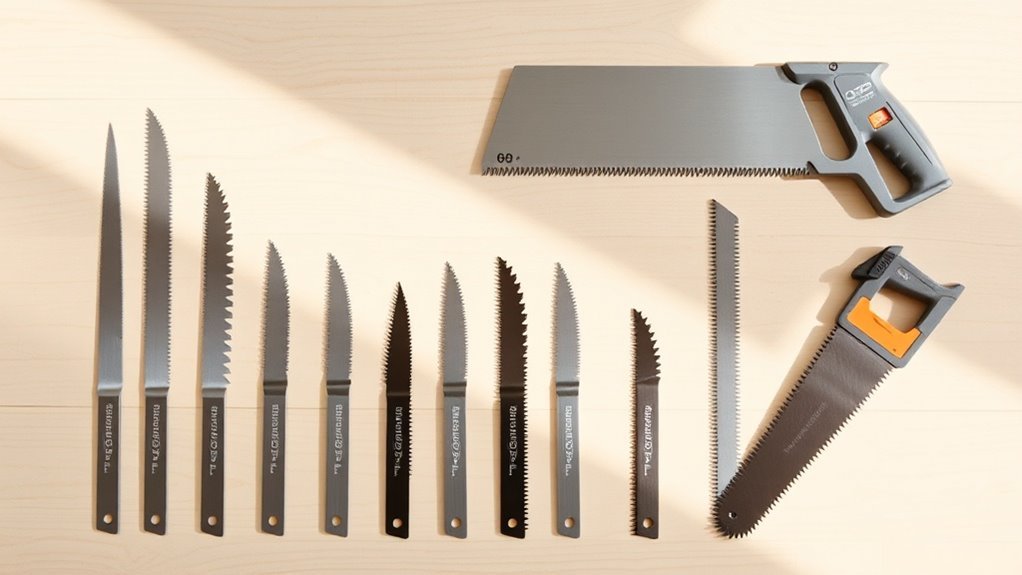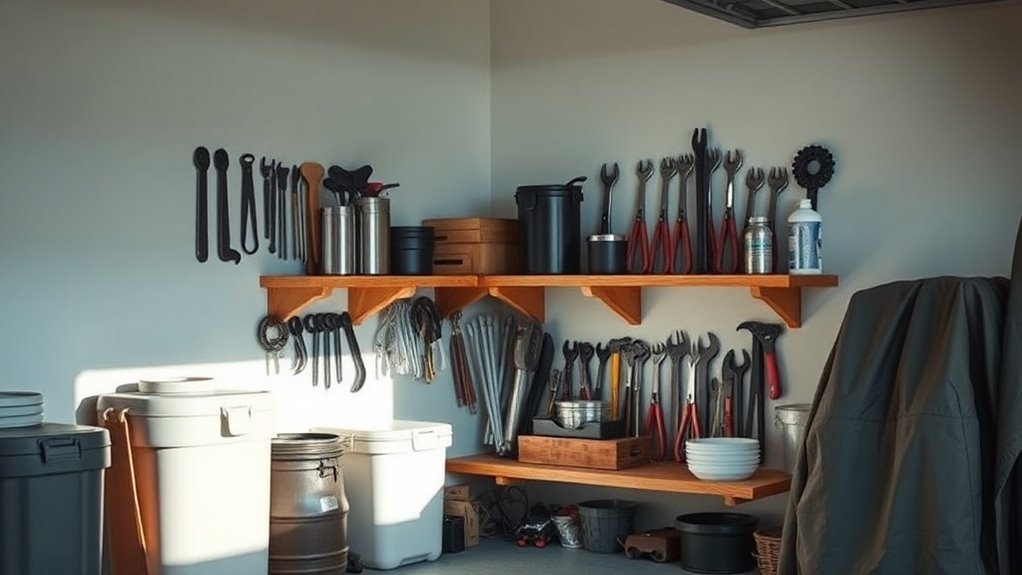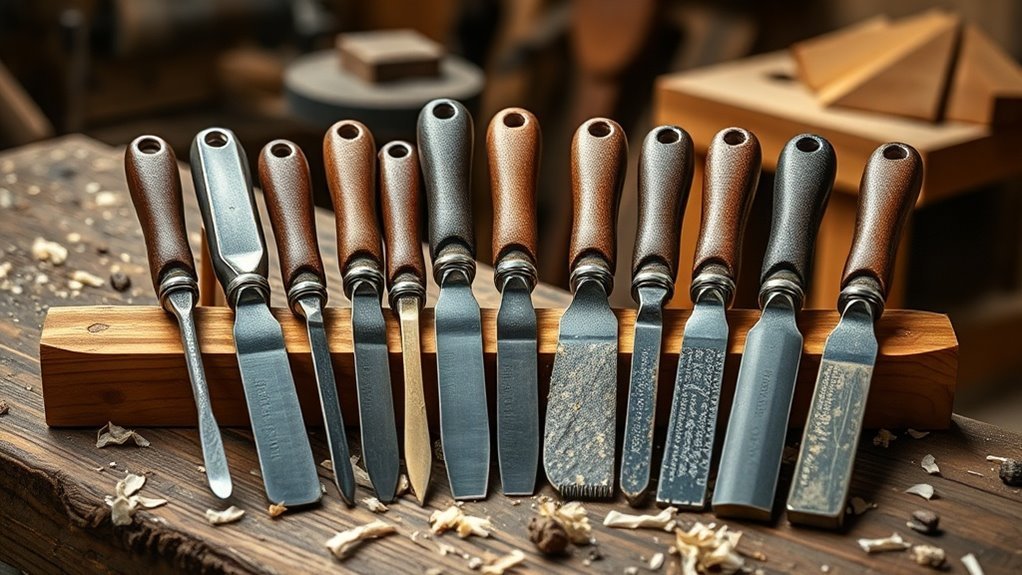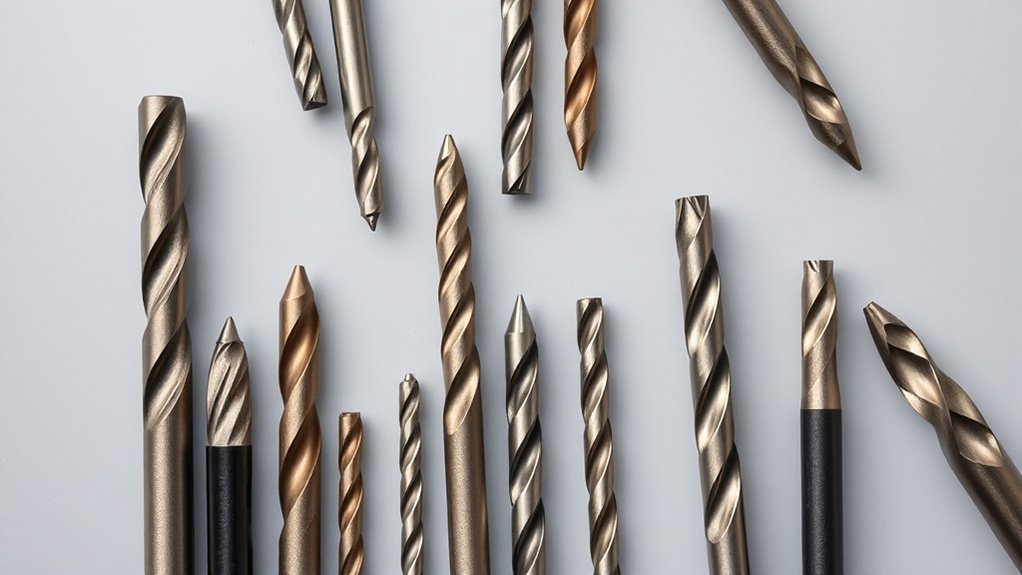Proper Grip and Posture for Using Hand Tools Safely
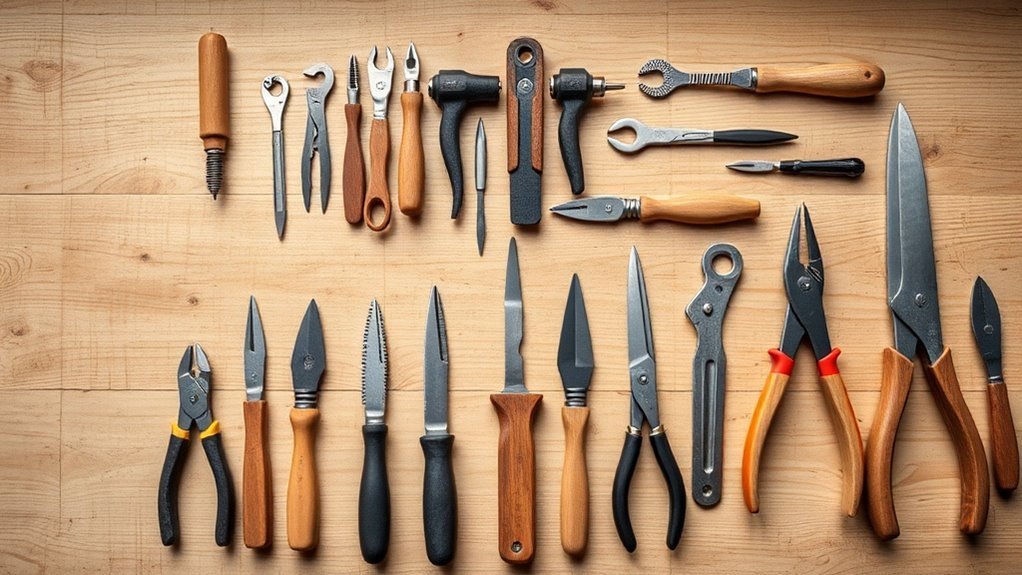
To use hand tools safely, you should maintain a firm grip and comfortable posture. Keep your fingers curled around the tool, align your wrist properly, and stand with your feet shoulder-width apart for stability. Make sure to avoid gripping too tightly, as it can lead to fatigue. Regular breaks and exercises can help improve your grip strength. By knowing how to adjust your grip and posture, you can enhance safety and efficiency while working with tools. There’s even more to explore on this topic.
Key Takeaways
- Maintain a firm yet relaxed grip around the tool to enhance control and prevent fatigue during use.
- Position your feet shoulder-width apart with slightly bent knees to ensure stability and reduce back strain.
- Keep your back straight and shoulders relaxed for better posture and optimized arm movement while using tools.
- Align your wrist with the tool’s handle to prevent strain and maximize tool performance during operation.
- Take regular breaks to stretch and rest your hands, helping to reduce fatigue and promote safer tool handling.
Understanding the Importance of Grip and Posture
When it comes to using hand tools, understanding the importance of grip and posture can make all the difference in your efficiency and safety.
Maintaining a firm grip allows you to control the tool better, reducing the risk of slips and accidents. Your grip should be comfortable but secure, ensuring you aren’t straining your hands.
A secure grip enhances tool control and reduces slip-related accidents, ensuring comfort without straining your hands.
Posture plays an essential role too. Standing or sitting upright keeps your body aligned, preventing fatigue and potential injuries. You should position yourself so you can apply consistent pressure without overreaching or twisting.
Keeping your feet shoulder-width apart provides balance, ensuring stability while you work. By focusing on grip and posture, you’ll not only enhance your performance but also minimize the chance of injury in your projects. Additionally, employing appropriate safety gear can further protect you from potential hazards while using hand tools.
Essential Hand Tool Safety Guidelines
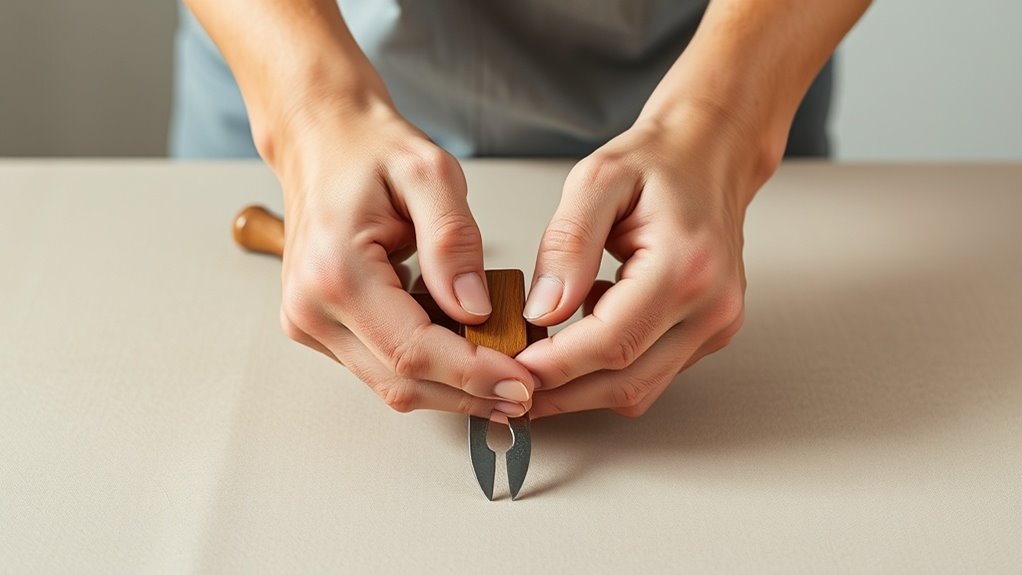
When working with hand tools, your safety should always come first. Choosing the right tool for the job and handling it correctly can prevent accidents and injuries.
Let’s go over some essential tips to guarantee you’re using your hand tools safely and effectively. Regular maintenance, including cleaning tools after each use, is crucial for ensuring your tools function safely and efficiently.
Hand Tool Selection Tips
Selecting the right hand tools is essential for both safety and efficiency in any project. Consider these tips when making your choice:
| Tool Type | Features to Look For | Safety Considerations |
|---|---|---|
| Screwdrivers | Ergonomic handle, magnetic tip | Check for slip-resistant grip |
| Hammers | Balanced weight, comfortable grip | Inspect for cracked heads |
| Pliers | Locking mechanism, insulated handles | Use appropriate size |
| Saw | Sharp, rust-free blade, comfortable handle | Always keep blades covered |
Proper Tool Handling Techniques
After choosing the right hand tools, mastering proper handling techniques is vital for safety and efficiency. Always grip tools firmly but not excessively tight to avoid fatigue.
Use both hands when possible for better control and stability, especially with larger tools. Keep your body aligned with the task at hand to maintain balance and reduce strain.
When cutting or scraping, make sure your hands are positioned away from the blade’s path. Avoid distractions and work within a clean space to prevent accidents.
Finally, never rush your movements; precision is key for achieving results while staying safe. By following these guidelines, you’ll enhance your skill while minimizing risks associated with hand tool usage.
The Anatomy of a Proper Grip

To effectively use hand tools, understanding proper hand positioning techniques is essential. You’ll want to explore different grip types to find what works best for you and the task at hand. Let’s break down the essentials for mastering your grip. Investing in tools with ergonomic handle design can significantly enhance your comfort and control during use.
Hand Positioning Techniques
Understanding the right hand positioning techniques is essential for achieving both efficiency and safety when using hand tools. Proper hand positioning not only improves your grip but also allows for better control and reduces the risk of accidents.
Here are some key techniques to keep in mind:
- Keep your fingers curled around the tool for a firm grip.
- Align your wrist with the tool’s handle to avoid strain.
- Maintain a relaxed hold to prevent fatigue during prolonged use.
- Position your thumb securely against the tool’s body for added stability.
Tool Grip Types
Having the right hand positioning techniques paves the way for mastering various tool grip types, which are essential for optimizing performance and control.
There are generally three main grip types you should know: the power grip, the precision grip, and the pinch grip.
The power grip, used for heavy tools like hammers, involves wrapping your fingers around the handle, providing maximum strength.
The precision grip is ideal for tasks needing fine motor skills, like using a screwdriver; here, your fingers should be positioned delicately for better control.
Ultimately, the pinch grip helps stabilize smaller objects, using your thumb and forefinger to hold the tool firmly.
Understand these grips, and you’ll enhance your safety and efficiency while working with hand tools.
Common Mistakes in Grip Technique
Many people overlook the importance of grip technique when using hand tools, leading to a range of common mistakes.
These errors can compromise safety and efficiency. Here are some mistakes you should watch out for:
- Holding the tool too tightly: This can cause fatigue and decrease control.
- Using an improper grip: Each tool requires a different grip for ideal performance.
- Failing to maintain a stable wrist: A wobbly wrist can lead to accidents and inaccuracies.
- Neglecting hand positioning: Poor hand placement can inhibit leverage and power.
Using hand tools can enhance precision and control, making it essential to master proper grip techniques for effective and safe crafting.
Adjusting Your Grip for Different Tools
When using different hand tools, adjusting your grip is vital for effective use and safety.
Each type of tool requires a unique grip technique to guarantee you maintain control and achieve the best results.
Understanding hand position is essential, as it can markedly impact your performance and comfort while working. Proper grip techniques also contribute to ergonomic tool design, which aims to reduce strain and enhance comfort during gardening activities.
Types of Hand Tools
Different hand tools require specific grips to maximize control and efficiency. Understanding the nuances of each tool can make a huge difference in your projects.
Here are some common types of hand tools and the grips you might adjust to:
- Screwdrivers: Use a comfortable pinch grip for better torque.
- Pliers: Employ a full grip to enhance control over larger tasks.
- Hammers: Hold near the end of the handle for better swing and reduced vibration.
- Hand Saws: Grip the handle firmly for stability while allowing some wrist flexibility.
Adapting your grip according to the tool can enhance your safety and effectiveness.
Always remember to practice with different grips to find out what feels most comfortable and efficient for you!
Grip Techniques Overview
Though each hand tool has its specific grip, adjusting your technique can significantly enhance your performance and comfort. For example, a firm but relaxed grip on a hammer increases control, while a loose hold on a file allows for smoother strokes. Pay attention to the tool’s weight and shape; this influences how you should grip it.
| Tool | Grip Technique |
|---|---|
| Hammer | Firm grip, wrist pivot |
| Screwdriver | Pinch grip, light pressure |
| Pliers | Full grip, leverage focus |
Experiment with these techniques tailored to each tool, as it can make a real difference in your efficiency and reduce the risk of strain or injury.
Hand Position Importance
Adjusting your grip based on the tool you’re using can greatly influence your effectiveness and safety. Each hand tool requires a specific grip to guarantee precision and control.
Misgripping can lead to accidents and poor results. Here’s what to reflect on for different tools:
- Pliers: Use a firm grip to maximize leverage while keeping fingers clear of the cutting area.
- Screwdrivers: Hold the handle comfortably, guaranteeing your thumb aligns with the shaft for torque.
- Hammers: Maintain a relaxed but strong grip, allowing for a full swing without losing control.
- Wrenches: Keep a two-handed grip for larger tasks, guaranteeing stability and preventing slippage.
Best Practices for Body Positioning
When using hand tools, maintaining proper body positioning is essential not just for comfort but also for efficiency and safety. You should stand with your feet shoulder-width apart, bending your knees slightly to maintain balance. Keep your back straight and your shoulders relaxed. Position your tools close to your body to minimize strain. Integrating ergonomic principles into your body positioning can further enhance comfort and reduce injury risks.
| Body Positioning Tips | Benefits |
|---|---|
| Feet shoulder-width apart | Enhances stability |
| Slightly bent knees | Reduces lower back strain |
| Straight back | Promotes good posture |
| Tools close to body | Decreases reach strain |
| Relaxed shoulders | Improves arm movement |
Strategies for Reducing Strain and Fatigue
To keep strain and fatigue at bay, it’s important to adopt techniques that promote efficiency and comfort while using hand tools.
Here are some strategies you can implement:
- Take Breaks: Regularly step away to stretch and rest your hands, reducing tension and fatigue.
- Use Proper Tools: Select ergonomic tools designed to minimize strain on your hands and wrists.
- Adjust Your Grip: Maintain a relaxed grip—tight grips can lead to early fatigue and discomfort.
- Stay Hydrated: Drink water throughout your work session; dehydration can contribute to fatigue.
The Role of Foot Placement and Balance
Proper foot placement and balance are essential for maintaining stability and control while using hand tools. Your feet should be shoulder-width apart, grounding you firmly as you work. This stance not only supports better posture but also reduces the risk of slips and falls.
| Foot Placement Tips | Benefits |
|---|---|
| Stand shoulder-width | Promotes balance |
| Point toes slightly out | Enhances stability |
| Distribute weight evenly | Reduces fatigue |
Being aware of your balance allows you to react quickly if needed, especially when using tools with force. Keep your core engaged and adjust as necessary to guarantee you’re always in a strong position while working.
Exercises to Improve Grip Strength
A strong grip is essential for effectively handling hand tools, and incorporating specific exercises into your routine can greatly enhance your grip strength.
A strong grip is vital for handling hand tools effectively; specific exercises can significantly improve your grip strength.
You don’t need fancy equipment—just your body and some everyday items. Here are a few exercises to take into account:
- Squeezing a Stress Ball: Grip and hold for several seconds, then release. Repeat for multiple sets.
- Wrist Curls: Use a light weight or resistance band to strengthen your forearms.
- Finger Extensions: Wrap a rubber band around your fingers and spread them apart for resistance.
- Plate Pinches: Hold a weight plate between your fingers for as long as possible.
These simple exercises can boost your grip strength, making it easier to handle tools safely and effectively.
Assessing Your Workspace for Safety
Creating a safe workspace is essential for anyone using hand tools. Start by clearing your area of clutter and making sure that it’s well-lit. This’ll help you see what you’re working on and prevent accidents.
Check for any slippery surfaces and fix them; a rubber mat can provide extra grip. Make sure tools are stored properly and within reach, so you won’t have to stretch or bend awkwardly while working.
Inspect your tools regularly for any signs of wear or damage—using malfunctioning tools can lead to serious injuries.
Finally, verify that your workspace is well-ventilated, especially when working with materials that produce fumes. A safer workspace sets you up for success and keeps accidents at bay.
Questions
What Are the Signs of Improper Grip and Posture?
If you’re experiencing discomfort, fatigue, or difficulty controlling your tools, you might be gripping them too tightly or standing awkwardly. Watch for strain in your hands, wrists, or back, which can indicate improper grip and posture.
Can My Grip Technique Affect Tool Performance?
Imagine trying to tame a wild stallion; your grip’s the reins. A solid, confident technique enhances tool performance, while a weak hold can turn a simple task into a chaotic rodeo of frustration.
How Often Should I Reassess My Grip and Posture?
You should reassess your grip and posture regularly, especially when switching tasks or feeling discomfort. It’s wise to check in every few hours or after completing significant work to guarantee you’re maintaining ideal safety and efficiency.
Are There Specific Tools That Require Unique Grip Methods?
Every tool’s a dancer, requiring its own rhythm. Yes, certain tools like chisels or hammers do need unique grips for precision. Embracing their idiosyncrasies guarantees safer, smoother movements as you create with confidence.
How Can I Train My Body for Better Tool Use Efficiency?
To train your body for better tool use efficiency, practice strength exercises focusing on your wrists and grip, stretch regularly to improve flexibility, and develop good posture habits that enhance control and reduce fatigue during tasks.
Conclusion
To sum up, mastering grip and posture while using hand tools is like weaving a safety net around your DIY projects. By keeping your grip firm and your stance balanced, you reduce the risk of accidents and strain. Remember to regularly assess your workspace and adjust your techniques as needed. Embrace these practices, and you’ll find that not only does your work improve, but so does your confidence. Stay safe, and let your creativity flow!

